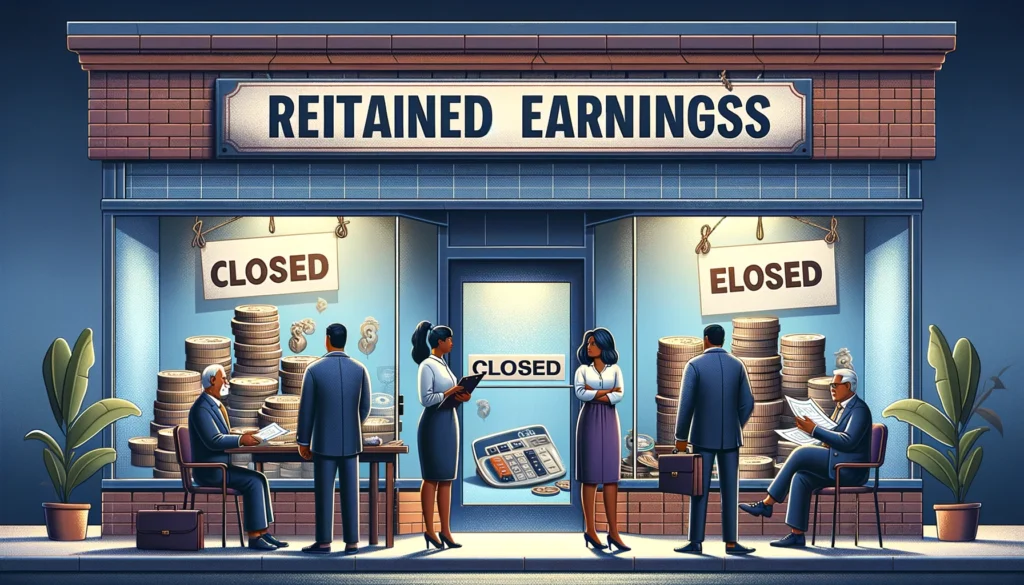When a business reaches the end of its journey, a crucial financial aspect comes into the spotlight: What Happens to Retained Earnings When a Business Closes?
Retained earnings refer to the accumulated net income or profits of a company since its inception that are not paid out as dividends. These retained profits act as crucial financial reserves for fuelling the company’s growth plans and strategic investments. They represent not just the historical profits of a business, but also its capacity to reinvest and grow. However, the fate of these earnings comes into question when a business shuts down.
The closure of a business can occur due to reasons like bankruptcy, the retirement of founders, or lack of profitability. Such closures lead to the liquidation of company assets and settlement of its liabilities. But how do these outcomes impact the company’s retained earnings specifically? What happens when retained earnings take a hit or turn negative?
Understanding the distribution and reporting of retained earnings is vital during business closure to assess the financial impact accurately. It influences decisions around paying shareholders and reinvestment of funds saved from profits. Proper closure planning considering retained earnings can cushion the blow of losses.
This article will provide clarity around key considerations regarding retained earnings when winding up operations. It will cover the liquidation process, managing creditor settlements, updating financial statements, and strategies to handle negative retained earnings. Exploring these facets can empower entrepreneurs to make informed choices about reinvesting profits as their venture comes to an end.
The Nature of Retained Earnings
Retained earnings refer to the accumulated net income or profits that a company decides to retain rather than distribute as dividends to shareholders. These retained profits build up on the balance sheet over time under shareholder’s equity.

- Sources of Retained Earnings: Primarily, they stem from net income, the profit a company earns after all expenses and taxes. A portion of this net income is often distributed as dividends, with the remainder added to the retained earnings.
- Role in Financial Strength: Retained earnings are vital for a company’s financial health. They can be used for:
- Business investment: Reinvesting in growth opportunities or new ventures.
- Debt settlement: Paying off existing liabilities to improve financial stability.
- Profit reinvestment: Funding research and development or expanding operations.
- Impact on Stability: A robust retained earnings balance can signify a financially stable and mature company, capable of weathering economic downturns or investing in future growth.
Firms reinvesting profits tend to enjoy greater shareholder trust and higher market valuations over time as they display financial stability. In essence, prudent retention and reinvestment of earnings allow firms to fuel growth organically while also keeping shareholders happy through consistent returns.
Impact of Business Closure on Retained Earnings
When a business closes, its retained earnings are significantly affected. This impact is a complex interplay of various financial processes:
- Asset Liquidation and Distribution: During corporate liquidation, assets are sold off to settle debts. The outcome of this process greatly influences the fate of retained earnings.
- Settling Creditors: Priority is given to settling debts with creditors. Only after all liabilities are cleared, can any remaining funds be considered part of retained earnings.
- Final Distribution: If there are positive retained earnings after settling all debts, these may be distributed to shareholders. However, in cases of negative retained earnings or insolvency, shareholders might not receive anything.
- Financial Reporting: Updating the retained earnings statement is crucial for accurate financial disclosure. It reflects the final financial outcome of the business closure.
These aspects highlight the complex nature of managing retained earnings during a business wind-down, emphasizing the importance of strategic financial planning and asset management in this process.
Assets Liquidation in Business Closures
When a business shuts down, liquidating its assets is one of the foremost tasks at hand. Asset liquidation involves selling all tangible assets like property, plant, inventory, etc. to generate cash and recover capital.
In most cases, the cash gathered from liquidating company assets first pays off the business’ outstanding debt and liabilities owed to lenders and creditors. This includes expenses like rent, utilities, employee salaries, and vendor payments that may be pending.

Once obligations are cleared, any leftover liquidated capital can cover shareholders’ equity which includes components like retained earnings reserves. However, dues and liabilities often consume the bulk of proceeds from asset sell-offs. Negative retained earnings balances indicate that shareholders’ equity has taken a larger hit.
If liquidated assets fall short of covering debts, companies file for insolvency leading to complex legal battles with creditors. Prioritized payment plans are established based on strict guidelines. In extreme cases, founders may even face personal bankruptcy with long-term financial implications.
In essence, asset liquidation forms the crux of tying up loose ends but has a significant bearing on retained earnings balances due to liability payouts. Careful tracking of proceedings can reveal the true extent of losses. We now turn to the distribution model for any capital left after creditor settlements during closure.
Financial Reporting and Retained Earnings
When winding down operations, it is crucial for companies to provide updated, accurate financial statements reflecting closure decisions. This includes reworking balance sheets, income statements, and statements of retained earnings.
Specifically, retained earnings balances need careful readjustment for profits/losses from asset liquidation, creditor payments, and potential insolvency settlements. The net impact must be reported on shareholders’ equity while disclosing these closure transactions.
If liquidation yields positive returns after clearing debts, retained earnings balances can reflect surpluses potentially available for distribution to shareholders. However, if obligations exceed asset sell-off proceeds, loss implications and revised deficits need documentation.

Additionally, companies must file final tax returns incorporating financial outcomes from the cessation of business. Tax authorities need notification regarding any future retained earnings distribution for shareholder payouts along with settlement amounts.
In summary, precise financial reporting and disclosure during closure is vital for legal compliance, transparent shareholder communication, and appropriate adjustment of retained earnings reserves. This facilitates equitable settlement of cumulative profits or losses.
Tax Implications of Retained Earnings Distribution in Liquidation
When a business shuts down operations and distributes retained earnings to shareholders, it triggers capital gains tax liabilities. As retained earnings represent cumulative net profits over the years, they are subject to capital gains rules for shareholders.
Specifically, distributed retained earnings are treated as capital gains income for tax purposes similar to income from stocks or property sales. So shareholders bear the burden of taxes on disbursement amounts in their individual income tax returns.
However, it is worth noting that dividends paid out of retained earnings during normal business operations are subject to different tax rates. Only distributions as part of liquidation and closure proceedings are categorized distinctly as capital gains.
Companies can ease tax implications for shareholders by opposing liquidation till obligations are met without sizeable retained earnings reserves. Careful structuring of disbursement tranches aligned to minimization strategies for long-term capital gains can also offer relief. Overall though, closure payouts from retained earnings do attract substantive tax obligations.
In summary, entrepreneurs must account for capital gains tax rules while navigating liquidation distributions involving retained earnings. Advance planning and calculated approaches help limit financial burdens.
Strategies for Retained Earnings
Effectively managing retained earnings is crucial for a business’s financial health and strategic growth. Here, we explore various approaches to maximize the benefits of retained earnings.

Reinvestment Approaches
- Strategic Investment: Utilizing retained earnings for strategic business investment is a key approach. This involves identifying growth opportunities and reinvesting profits to fuel expansion.
- Risk Assessment: Before reinvestment, assessing potential risks and returns is vital. This ensures that the reinvested earnings contribute positively to the company’s growth.
Reserving Profits for Future Goals
- Building Financial Reserves: Retained earnings can act as financial reserves, providing a safety net for future uncertainties.
- Goal Alignment: Aligning these reserves with long-term business goals ensures that funds are available for future projects or expansions.
Reporting Profits Accurately
- Transparency in Financial Reporting: Accurate financial reporting, including a detailed retained earnings statement, is essential for transparency and trust.
- Compliance with Financial Standards: Adhering to financial reporting standards and regulations is crucial in maintaining the integrity of reported earnings.
Managing Deficits Carefully
- Loss Management: In cases of negative retained earnings, implementing effective loss management strategies is key.
- Financial Planning: Careful financial planning helps in navigating periods of financial deficit, ensuring the business remains stable.
In each of these strategies, the focus is on prudent management and strategic use of retained earnings. This involves balancing risk with potential rewards, ensuring transparency in reporting, and preparing for future financial challenges.
At End
Retained Profits Remain crucial even during business closures. Entrepreneurs must track the fate of cumulative earnings reserves as operations wind down given their impact on growth prospects and shareholder settlements.
Liquidations and creditor negotiations consume most retained earnings. Carefully updated financial statements should capture revised balances while planning the next steps.
If sizeable reserves remain, balanced reinvestment across diversified ventures or structured payouts optimizing for taxes aid transparency. Deficit concerns may require developing mitigation strategies demonstrating continuation viability.
No business owner charts the closure path at inception. However careful financial planning considering the nuances of retained earnings distribution can make the process smoother for all stakeholders.
In wrapping, retention and distribution choices around retained earnings during closures require both business pragmatism and shareholder empathy. The path ahead can be paved more smoothly through responsible tracking, reporting, and deployment of cumulative profits.
With the right closure strategies, retained profits can still fuel growth opportunities even as the current entrepreneurial journey ends opening possibilities for fresh ones.
Muhammad Asif Saeed has extensive experience in commerce and finance. Specifically, He holds a Bachelor of Commerce degree specializing in Accounts and Finance and an MBA focusing on Marketing. These qualifications underpin his understanding of business dynamics and financial strategies.
With an impressive 20-year career in Pakistan’s textile sector, including roles at Masood Textile (MTM) and Sadaqat Limited, excelling in business & financial management. His expertise in financial and business management is further evidenced by his authoritative articles on complex finance and business operation topics for various renowned websites including businessproplanner.com,businesprotips.com,distinctionbetween.com, trueqube.com, and bruitly.com, demonstrating his comprehensive knowledge and professional expertise in the field.

